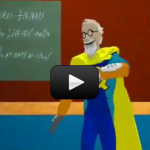This video gets you started on the right foot. We’ll outline what’s coming up for this unit and how to get the most out of our lesson together. Enjoy!
[am4show have='p8;p9;p11;p38;p72;p77;p92;' guest_error='Guest error message' user_error='User error message' ]
Scientific Concepts:
- All matter is made up of some kind of atom.
- Visible matter is made up of protons, neutrons, and electrons.
- A proton has a positive charge, a neutron has no charge, and an electron has a negative charge.
- When you split an atom or particle, it’s called fission. It’s how atomic bombs get their major amounts of energy.Fusion occurs when you squish atoms together. The sun creates its energy using fusion.
- Most of an atom’s mass is inside the nucleus.
- Depending on the types of particles you smoosh or split, you get different amounts of energy.
[/am4show]




